A Consultant's Guide to Ad Performance Metrics
- Chase McGowan

- Aug 25
- 16 min read
Ad performance metrics are the numbers that tell you the real story of your campaigns. They show you what’s working, what's a waste of money, and exactly where every dollar is going. Getting a handle on them is the first step in turning your ad spend from a necessary expense into a profitable investment.
Moving Beyond Vanity Metrics to Profitable Growth
Have you ever gotten a report from a big ad agency stuffed with impressive-sounding numbers like "impressions" or "reach"? These metrics look great on a slide deck but often do absolutely nothing for your bottom line. They're vanity metrics, designed to make you feel good and justify a hefty monthly retainer by showing your ad was seen by a lot of people—but not necessarily the right people. This is a classic move from bloated, impersonal agencies that lack a sharp, specialized focus.
As a hands-on Google Ads consultant, my entire philosophy is different. I believe every single dollar you spend must be tied directly to a measurable, profitable result. It’s not about getting the most eyeballs on your ad; it’s about getting the right ones to click, convert, and come back. This approach cuts straight through the fluff and hones in on the ad performance metrics that actually drive your business forward.
This guide is here to help you demand more from your ad budget. We're not just going to define metrics in a dry, academic way. We’ll connect them to real business growth by focusing on what truly matters:
Click-Through Rate (CTR): The very first pulse check of your ad's relevance.
Cost Per Click (CPC): The price you pay for a potential customer's attention.
Cost Per Action (CPA): The true, all-in cost of getting a new lead or sale.
Return On Ad Spend (ROAS): The ultimate scoreboard for profitability.
Don't think of these as separate numbers on a dashboard. They're all interconnected clues in the story of your campaign’s health. Understanding how they influence each other is the key to making smart decisions that build sustainable growth—a level of strategic insight a one-size-fits-all agency just can't deliver. It’s all about shifting the conversation from "how many people saw our ad?" to "how much revenue did that ad actually generate?"
Let's quickly break down the difference in focus. Large agencies often get caught up in metrics that look good but don't translate to profit, while a dedicated consultant is laser-focused on the numbers that hit your bank account.
Agency Metrics vs. Consultant Metrics
Metric Category | Typical Agency Focus (Vanity) | Expert Consultant Focus (Profitability) |
|---|---|---|
Top of Funnel | Impressions, Clicks, Reach | Click-Through Rate (CTR), Search Impression Share |
Cost Efficiency | Cost Per Click (CPC) | Cost Per Action (CPA), Cost Per Lead (CPL) |
Bottom Line | Click Volume | Return On Ad Spend (ROAS), Customer Lifetime Value (LTV) |
Overall Goal | "Brand Awareness," "Engagement" | Net Profit, Scalable Customer Acquisition |
This table isn't just about different columns; it's about a fundamentally different mindset. One is about activity, the other is about impact.
The infographic below shows how these core metrics build on each other. A high click-through rate is a great start, but it's just the first step on the path to real success.
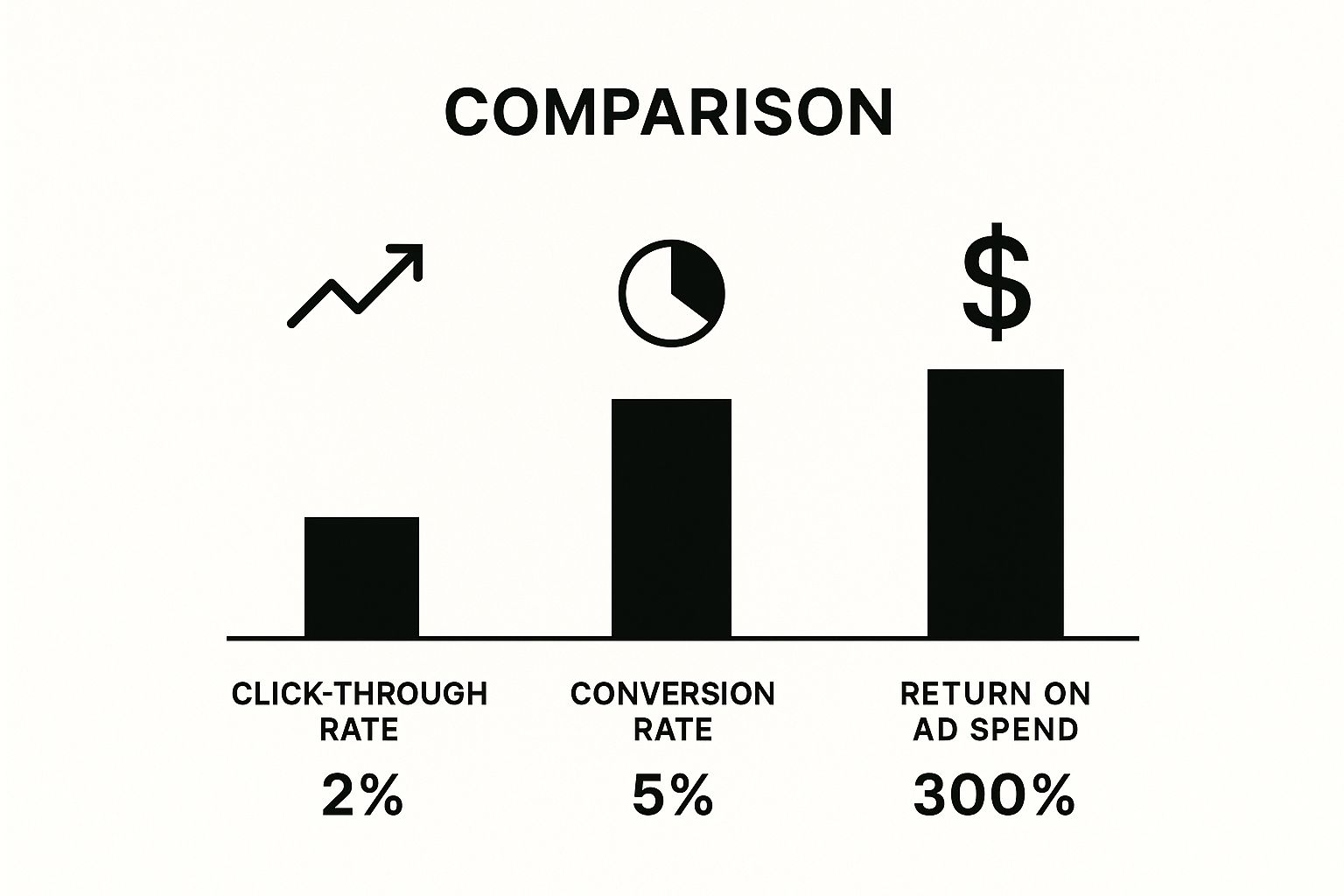
As you can see, a high CTR is only the beginning of the story. The real win comes from turning those clicks into profitable actions, which is ultimately measured by a strong, healthy ROAS.
Using Click-Through Rate as Your Relevance Barometer

Out of all the metrics you'll track, Click-Through Rate (CTR) is your first and fastest gut check on relevance. Think of it this way: your ad shows up (an impression), and the CTR tells you what percentage of people found your message compelling enough to actually click.
A low CTR is a massive red flag. It’s not just a number; it’s direct feedback from the market screaming that there’s a disconnect. Either your targeting is off, your ad copy is bland, or your offer simply isn't cutting through the noise.
This is exactly where a hands-on consultant shines and a big agency often stumbles. An agency might see a low CTR and suggest throwing more money at the problem to get more impressions. I see a puzzle that needs to be solved with precision, not a bigger budget.
What Is a Good CTR?
Honestly, defining a "good" CTR is tricky because it’s not a one-size-fits-all metric. It shifts wildly depending on your industry, the type of campaign you’re running, and even the keywords you’re bidding on.
Click-Through Rate (CTR) is simply the percentage of people who click your ad after seeing it. On average, you might see a 6.6% CTR for search ads, but that plummets to around 0.6% for display ads. That huge gap shows you the power of search intent—people on Google are actively looking for a solution, making them far more likely to click.
Improving your CTR is one of the most direct ways to boost your Quality Score, which is Google’s rating of your ad’s relevance. A better score almost always leads to paying less per click.
Key Takeaway: Industry benchmarks are a starting point, not the finish line. Your real goal should be to constantly beat your own historical performance. That’s how you know your ads are getting more relevant over time.
Instead of chasing an arbitrary number, a consultant digs into the context. Is a 2% CTR terrible for a high-intent, branded keyword? Absolutely. But could that same 2% CTR be a huge win for a broad awareness campaign on the Display Network? It's very possible.
How a Consultant Improves Your CTR
This is where expert-level management makes a real difference that bloated agencies often miss. They’re juggling dozens of accounts with cookie-cutter playbooks; I’m diving deep into the DNA of your business. Improving CTR isn't about some secret trick—it’s about the methodical, disciplined application of proven strategies.
Here are a few tactics I use that go way beyond the set-it-and-forget-it agency model:
Hyper-Relevant Ad Copy: I don’t just write ads; I craft headlines and descriptions that mirror the exact language of your target keywords. This creates an immediate connection and signals to the searcher that you have the answer they’re looking for.
Strategic Use of Ad Extensions: Sitelinks, callouts, and structured snippets aren’t just nice-to-haves. They are vital tools for making your ad bigger, more informative, and far more clickable. I systematically test different combinations to find what works.
Meticulous Keyword Grouping: I build super-tight ad groups where every single keyword is directly related to a highly specific set of ads. This laser focus on relevance is the single biggest driver of a high CTR.
This obsessive attention to detail creates a powerful feedback loop. A higher CTR tells Google your ads are relevant, which boosts your Quality Score. A better Quality Score means you pay less for each click and earn better ad positions. Our guide on how to **improve Google Ads performance and ROI** explores these connections in more detail. It all starts with earning that click.
Clicks vs. Conversions: Why Your Cost Per Action is the Only Metric That Matters
Are you paying for clicks, or are you paying for results?
It’s the most important question in advertising, and it’s where most big, impersonal agencies get it wrong. They love to flash a low Cost Per Click (CPC) and call it a win. But here's the hard truth: a cheap click that doesn't convert is just an expensive website visit. My entire focus as a specialist is on the number that actually impacts your bottom line: the Cost Per Action (CPA).
Think of it this way. CPC is the cover charge to get a potential customer into your club. CPA is what you pay when they actually buy a drink. Which one would you rather optimize for?
A low CPC can be dangerously misleading. An agency might brag about getting you clicks for $0.50. Sounds great, right? But if it takes 200 of those cheap clicks to get one single sale, your actual CPA is $100.
Now, what if I optimized your campaigns to a CPC of $4.00? That might seem high at first glance. But if those hyper-targeted, high-quality clicks convert every 10 clicks, your CPA is just $40. You're paying less than half for the same result.
The Consultant's Mindset: A low CPC is vanity. A profitable CPA is sanity. My strategy is built from the ground up to secure a low, sustainable Cost Per Action, because that's the truest measure of a campaign's financial health.
This is exactly where a dedicated expert approach breaks from the hands-off style of larger agencies. They simply don't have the time or specialized skill to do the granular, painstaking work required to control and lower your CPA. It’s a meticulous, ongoing effort that goes way beyond fiddling with a few bids.
For a deeper dive into controlling your ad spend, check out our guide on **decoding internet advertising cost for better ROI**.
How a Consultant Drives Down Your CPA
Lowering your true cost of acquisition isn't about finding some secret "optimize" button. It’s about a series of deliberate, interconnected actions that a specialist relentlessly manages. While an agency might set up a campaign and let it coast on autopilot, I’m in the trenches every day, actively eliminating waste.
Here are a few core tactics that demand the kind of detailed management you just don't get from a typical agency:
Implementing Granular Smart Bidding: This isn't just about setting a generic "Maximize Conversions" goal and hoping for the best. I segment campaigns to apply target CPA or target ROAS bidding with realistic goals based on your historical data. This tells Google's AI exactly what a conversion is worth to your business, stopping it from overspending on clicks that will never pay off.
Creating Tightly-Themed Ad Groups: This is a non-negotiable fundamental for me. I structure campaigns with hyper-specific ad groups where the keywords, ad copy, and landing pages are all in perfect harmony. This precision sends your Quality Score through the roof, which directly lowers the CPC for the clicks most likely to convert—slashing your CPA in the process.
Aggressively Managing Negative Keywords: This is where big agencies almost always drop the ball. I am constantly digging through search term reports to find and block irrelevant queries that trigger your ads and drain your budget. Every dollar not spent on a worthless click is a dollar saved, which directly improves your overall CPA.
These aren't one-time fixes. They demand constant monitoring and refinement—a level of hands-on attention that’s impossible for a big agency juggling dozens of accounts with junior-level staff. This is the individual expert advantage. My goal isn't just to report on your CPA; it's to actively and systematically drive it down, turning your ad spend into a predictable, profitable engine for growth.
Focusing on ROAS: The Metric That Matters to Your Bank
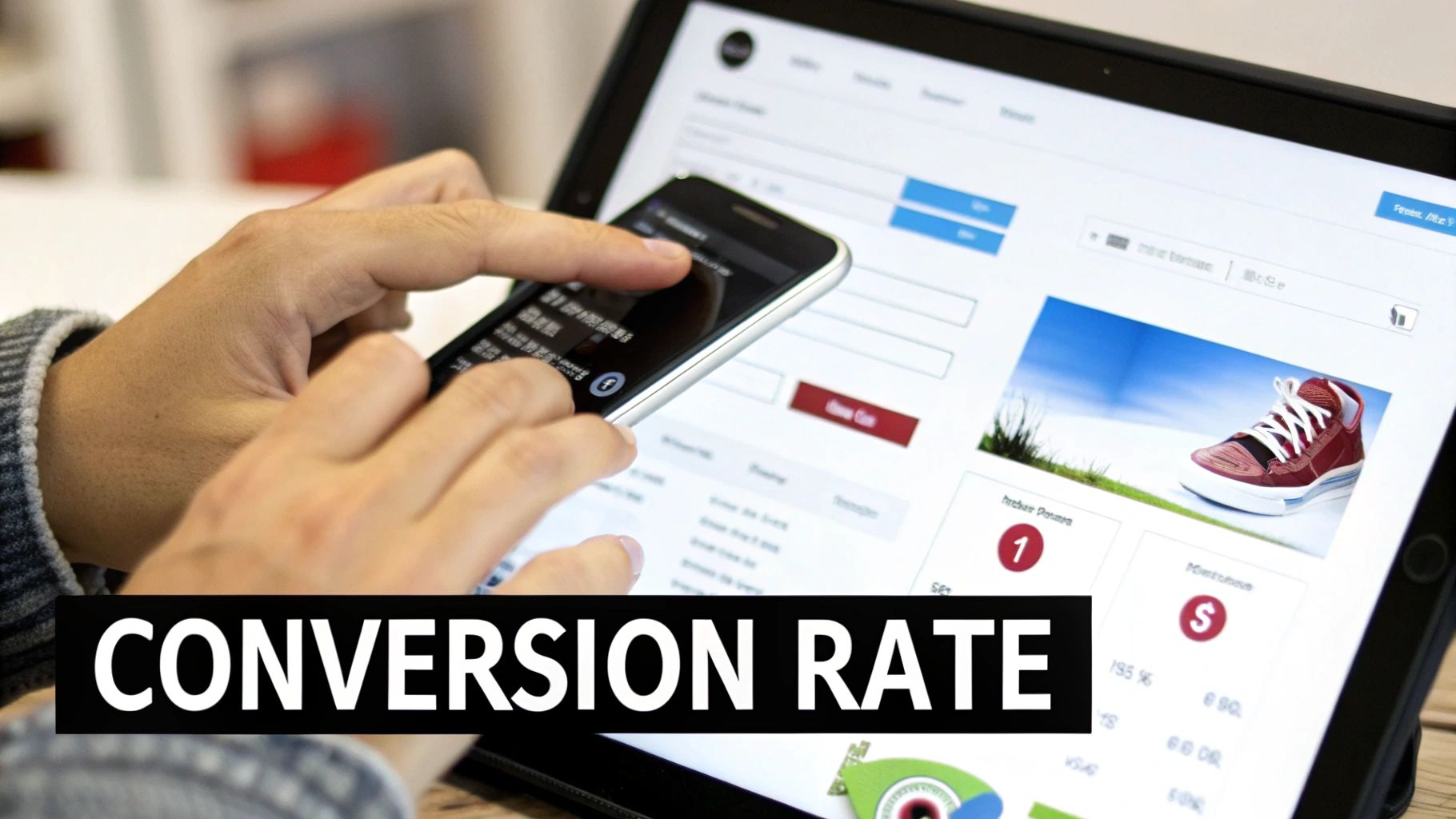
Impressions are fleeting, and clicks are just the start of the story. If you want to know the real financial impact of your advertising, only two ad performance metrics truly matter: Conversion Rate and Return On Ad Spend (ROAS).
These are the numbers that connect your campaigns directly to your bank account.
Let's start with Conversion Rate. This metric tells you how persuasive your entire sales process is, from the ad copy all the way to your landing page. It's the percentage of people who click your ad and then actually do the thing you wanted them to do—whether that's buying a product, filling out a form, or calling your office.
A low conversion rate paired with a high click-through rate is the classic sign of a broken promise. Your ad wrote a check that your landing page couldn't cash. But this is exactly where most big agencies stop. They'll celebrate the clicks and "leads," but for a real consultant, this is where the work is just getting started.
The Agency Trap of "Lead" Reporting
One of the biggest differences between an independent specialist and a bloated agency is how we define a "conversion." An agency will often set up basic form-fill tracking and report every single submission as a win. They'll hand you a shiny report showing they generated 100 "leads" and call it a success, easily justifying their management fee.
But you know the real story. Maybe only 10 of those leads were actually qualified. The other 90 were tire-kickers, spam, or people who were never going to buy. In that scenario, the agency's reported CPA is a fantasy, and you're paying for noise, not results.
The Consultant's Advantage: I don't just track leads; I track value. By connecting your ad account directly to your CRM and sales data, I can tell the difference between a low-quality inquiry and a high-value customer. This lets us optimize your campaigns not just for any conversion, but for the conversions that actually grow your revenue.
ROAS: The Ultimate Scoreboard of Profitability
This brings us to the king of all ad performance metrics: Return On Ad Spend (ROAS). This is the single most important number for understanding campaign profitability. It tells you exactly how much revenue you make for every dollar you spend on ads.
The math is beautifully simple:
ROAS = Total Revenue from Ads / Total Ad Spend
For example, if you spend $1,000 on a Google Ads campaign and it generates $5,000 in sales, your ROAS is 5x (or 500%). For every dollar you gave Google, you got five dollars back. It’s a brutally honest metric that leaves no room for excuses.
While it's related to ROI, understanding the specific differences is key to making smart financial decisions. You can dive deeper in our consultant's guide to **ROI vs. ROAS and what each means for real profit**.
How an Expert Maximizes Your ROAS
Improving your ROAS isn't about flipping a switch; it's a methodical process that requires a deep understanding of your entire business, not just your ad account. This is a level of detail that large agencies, with their cookie-cutter strategies, simply can't provide.
Here are a few strategies I use to directly improve this critical metric:
Focus on High-Value Conversions: By tracking actual revenue data, we can teach Google's bidding algorithms to go after users who look like your best customers, not just low-value lead form submissions.
Optimize the Entire Funnel: A poor ROAS is often a landing page problem, not an ad problem. I analyze user behavior on your site to find and fix the roadblocks, ensuring the expensive traffic you're buying has the best possible chance to convert.
Refine Your Offer: Sometimes, the issue isn't the ad or the page but the offer itself. We can test different price points, bundles, or calls to action to find the sweet spot that maximizes revenue.
Ultimately, my goal is to turn your ad spend into a predictable profit machine. While agencies are busy reporting on vanity metrics, a dedicated consultant is focused on the one number that actually matters to your business's survival and growth: your Return On Ad Spend.
How Quality Score Becomes Your Secret Weapon
If you could only focus on one metric to improve your Google Ads performance, which would it be? Most people jump to ROAS or CPA, but the real lever behind the scenes—the one that makes everything else cheaper and more effective—is your Quality Score.
Think of it as your reputation with Google. A high score is like having an 800 credit score; you get the best rates (lower costs) and preferred treatment (better ad positions). A low score? You'll pay a premium for everything, if you get shown at all.
This is where the difference between a hands-on consultant and an overpriced agency becomes painfully obvious. When a campaign struggles, an agency’s first move is almost always to bid higher. They just throw more of your money at the problem. As a specialist, I see that as a lazy, expensive, and frankly, amateur tactic.
My first move is to dissect and rebuild your Quality Score. This is the deep, technical work that turns a money pit of a campaign into a cost-effective powerhouse. A high Quality Score isn’t a vanity metric; it directly lowers your CPC and boosts your Ad Rank. You pay less to get a better spot on the page. It's the ultimate secret weapon, but you can't unlock it with a set-it-and-forget-it agency approach.
The Three Pillars of Quality Score
Google’s algorithm isn't some black box. They tell us exactly what goes into this critical score. It all boils down to three core components, and getting these right is my primary focus when I take over an account.
Expected Click-Through Rate (CTR): Based on historical data, how likely is someone to click your ad when it appears for a keyword? This is Google’s measure of your ad’s magnetic pull.
Ad Relevance: Does your ad copy actually match what the person searched for? If someone types in "men's trail running shoes," an ad for a generic shoe store is dead on arrival. The ad has to speak directly to the search.
Landing Page Experience: The job isn't done when they click. Does the page you send them to deliver on the ad's promise? Is it relevant, easy to use, and trustworthy? A slow, confusing landing page will tank your score.
A big agency might glance at these factors. A consultant lives and breathes them. Each pillar is a project to be perfected, because a small lift in one area creates a ripple effect of savings and performance across your entire account.
The Expert Advantage: A specialist doesn’t just bid higher to beat the competition; we outsmart them. By methodically improving the three pillars of Quality Score, we force the system to reward your ads with better placement for less money. This is the strategic work that turns ad spend into a true competitive advantage.
Diagnosing and Fixing a Low Quality Score
When I inherit an account, the first thing I do is run a deep-dive audit of the Quality Score. It’s like a doctor running diagnostics to find the root cause of an illness instead of just prescribing painkillers for the symptoms. A low score is always a sign of a fundamental disconnect between your keywords, ads, and landing pages.
Here’s the methodical approach I use to fix it—a process that requires granular attention an agency account manager juggling 30 clients simply can't provide:
Restructure Ad Groups: The most common culprit is a messy, disorganized campaign structure. I rebuild ad groups into hyper-focused, tightly-themed clusters where every single keyword is directly relevant to the ad copy. This immediately fixes the Ad Relevance problem.
Rewrite and Test Ad Copy: Generic ads get ignored. I write multiple, sharp ad variations that mirror the user's search intent, often using dynamic keyword insertion and compelling calls-to-action to systematically drive up the expected CTR.
Optimize Landing Pages: I walk through the entire user journey, from the click to the conversion. This means making sure the landing page headline matches the ad, the content is genuinely useful, and the page loads in a snap. This hands-on analysis of the landing page experience is a critical step most agencies completely skip.
This isn't a one-and-done job. It's a continuous cycle of testing, measuring, and refining. It’s the kind of dedicated, expert work that transforms your ad account from a cash drain into a lean, mean, profit-generating machine.
Putting It All Together: A Consultant's Approach to Analysis

Understanding individual ad performance metrics is one thing, but knowing how to connect them to build a profitable strategy is a completely different game. Honestly, this is where the gap between an overpriced, bloated agency and a dedicated consultant becomes a canyon.
An agency will often send you a flashy report filled with graphs showing isolated numbers—your CTR, your CPC, your ROAS—but with zero context or actionable insight.
They report the what. My job is to explain the why and map out the what's next.
A specialist’s approach is about connecting the dots to tell the true story of your campaign. We move beyond simply reporting that your Cost Per Click (CPC) went up. We dig deeper to see how that rising CPC is hitting your Return On Ad Spend (ROAS) and then diagnose the root cause. Is it a Quality Score issue? A new, aggressive competitor? Something else entirely?
We don't just see numbers on a screen; we see relationships and consequences.
The Agency Report vs. The Consultant Analysis
Imagine you get two different performance summaries for the exact same campaign. One is heavy on data points, the other is heavy on actual insight. The difference in value is massive.
The Agency Report: "Your CTR is 4%, CPC is $3.50, and CPA is $50. Here are seven charts showing these numbers trended over the last 30 days."
The Consultant Analysis: "Your CTR is solid at 4%, but our CPA has crept up to $50. I've traced this to a drop in conversion rate on our main landing page, which is slowing down our ROAS. I'm launching an A/B test on the page headline to fix this and get our CPA back under our $40 target."
See the difference? One is passive reporting; the other is active problem-solving. This is the core advantage of working with a specialist. We don't just deliver data; we deliver a data-driven plan for growth.
A Checklist for Actionable Insights
You don't need a hundred-page report to understand what’s going on in your account. You just need to ask the right questions. When you look at your own ad performance metrics, use this checklist to think like a consultant and spot the trends that actually matter.
CTR vs. Conversion Rate: If your CTR is high but your conversions are low, what's broken on your landing page? Is there a disconnect between the ad's promise and the page's offer?
CPC vs. CPA: Is a rising CPC directly causing a higher CPA, or is something else dragging down efficiency after the click?
ROAS vs. Ad Spend: Are you maintaining a profitable ROAS as you increase your budget, or is efficiency dropping as you try to scale? This tells you if your growth is healthy.
Quality Score Trends: Is your Quality Score improving over time? If not, which component—CTR, ad relevance, or landing page experience—is the weak link pulling it down?
Analyzing these relationships is what turns raw data into a roadmap. It’s the difference between staring at a dashboard and actually steering the ship.
Your Top Questions About Ad Performance, Answered
Let's cut through the noise. When you're running a business, you don't have time to get bogged down in a sea of acronyms. Here are straight answers to the questions I hear most often from clients who are tired of generic agency reports.
How Often Should I Be Checking My Ad Metrics?
A quick, daily five-minute check-in on any active campaign is smart. It’s your early warning system for a sudden spike in costs or a broken link. Don't touch anything, just observe.
The real strategy, however, comes from a deeper weekly analysis. That’s where you can spot actual trends without getting whiplashed by daily fluctuations. This is where a consultant’s value really shines. Instead of just dumping raw data in your inbox (a classic agency move), my job is to do that rigorous analysis for you. I’ll tell you what’s happening, why it matters, and what we’re going to do about it.
What’s a Good ROAS?
There’s no magic number. A “good” Return On Ad Spend is completely dependent on your profit margins.
While a 4:1 ratio—meaning you make $4 for every $1 you spend—is a common industry benchmark, it might be totally wrong for you. A business selling high-margin software could be incredibly profitable at a 3:1 ROAS. A retailer with tighter margins might need a 10:1 ROAS just to stay afloat.
The first step is always to calculate your actual break-even point. From there, we can set a realistic target that drives real profit for your specific business, not just chase a vanity metric.
Why Is My Click-Through Rate High but My Conversion Rate Is Low?
Ah, the classic scenario. This is a dead giveaway that there’s a massive disconnect between your ad and your landing page.
Your ad is doing its job—it's compelling enough to earn the click. But once people land on your site, the promise is broken and they're bouncing.
This usually points to one of a few culprits: the message on the landing page doesn't match the ad, the user experience is clunky, the page loads too slowly, or the offer itself isn't what the user expected. Fixing this isn't just an "ad problem"; it requires a holistic view that connects ad creative to on-page optimization. That's a level of detail siloed agency teams often miss.
Tired of confusing reports and metrics that don't connect to your bottom line? Come Together Media LLC cuts through the noise. I provide the expert, one-on-one Google Ads management you need to turn ad spend into predictable profit. Book your free consultation today and let's build a strategy that actually works.




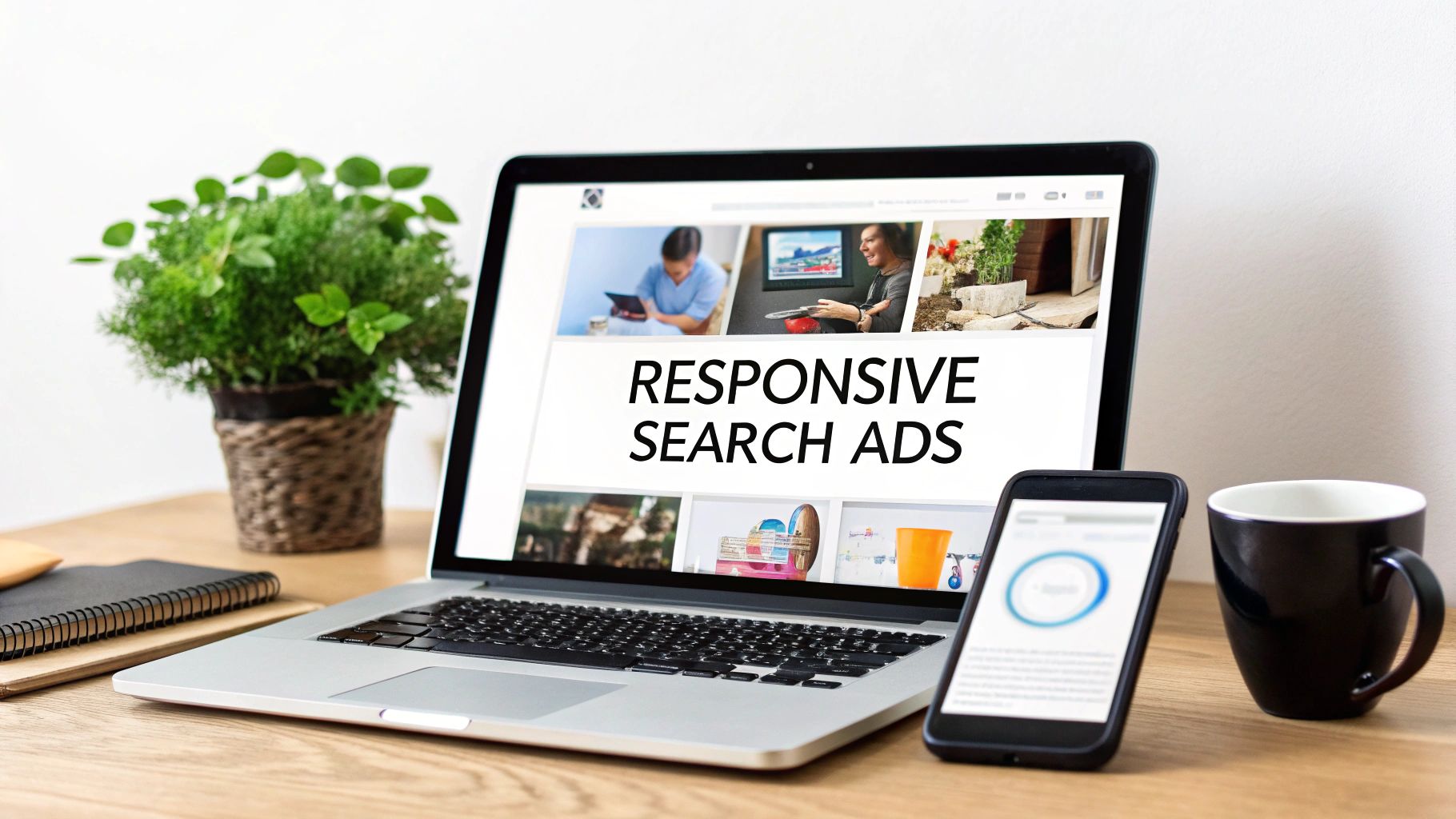

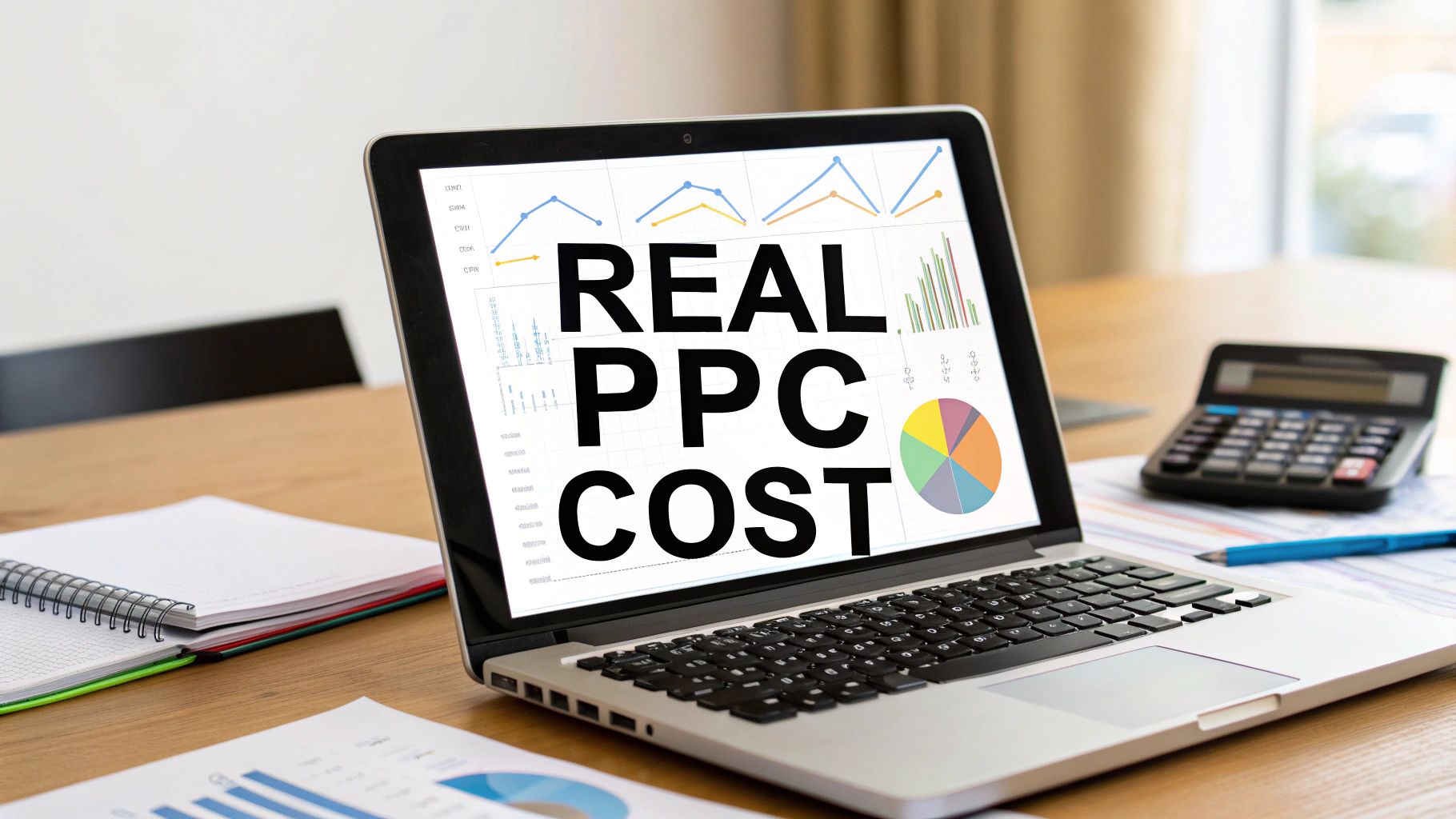



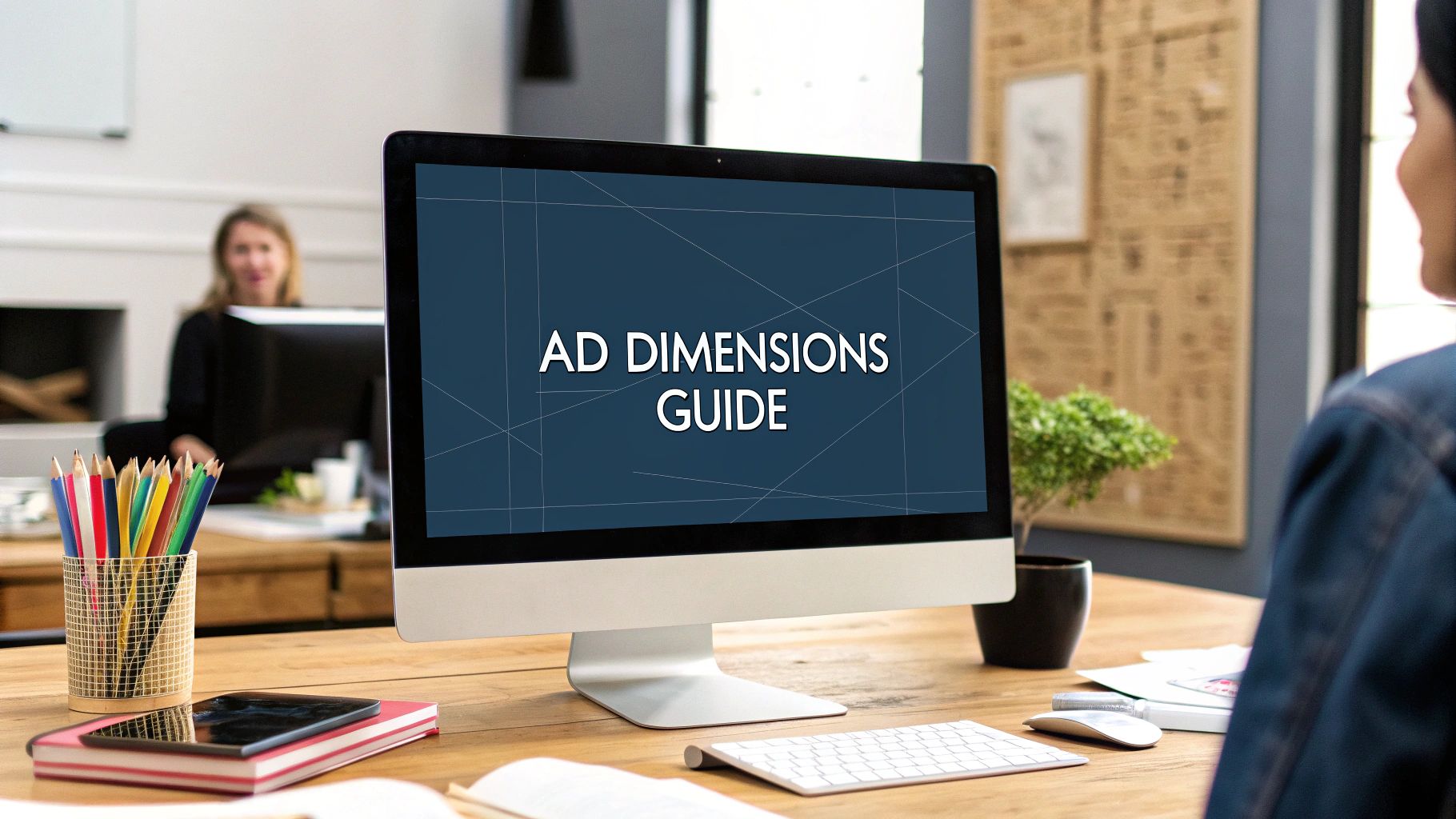

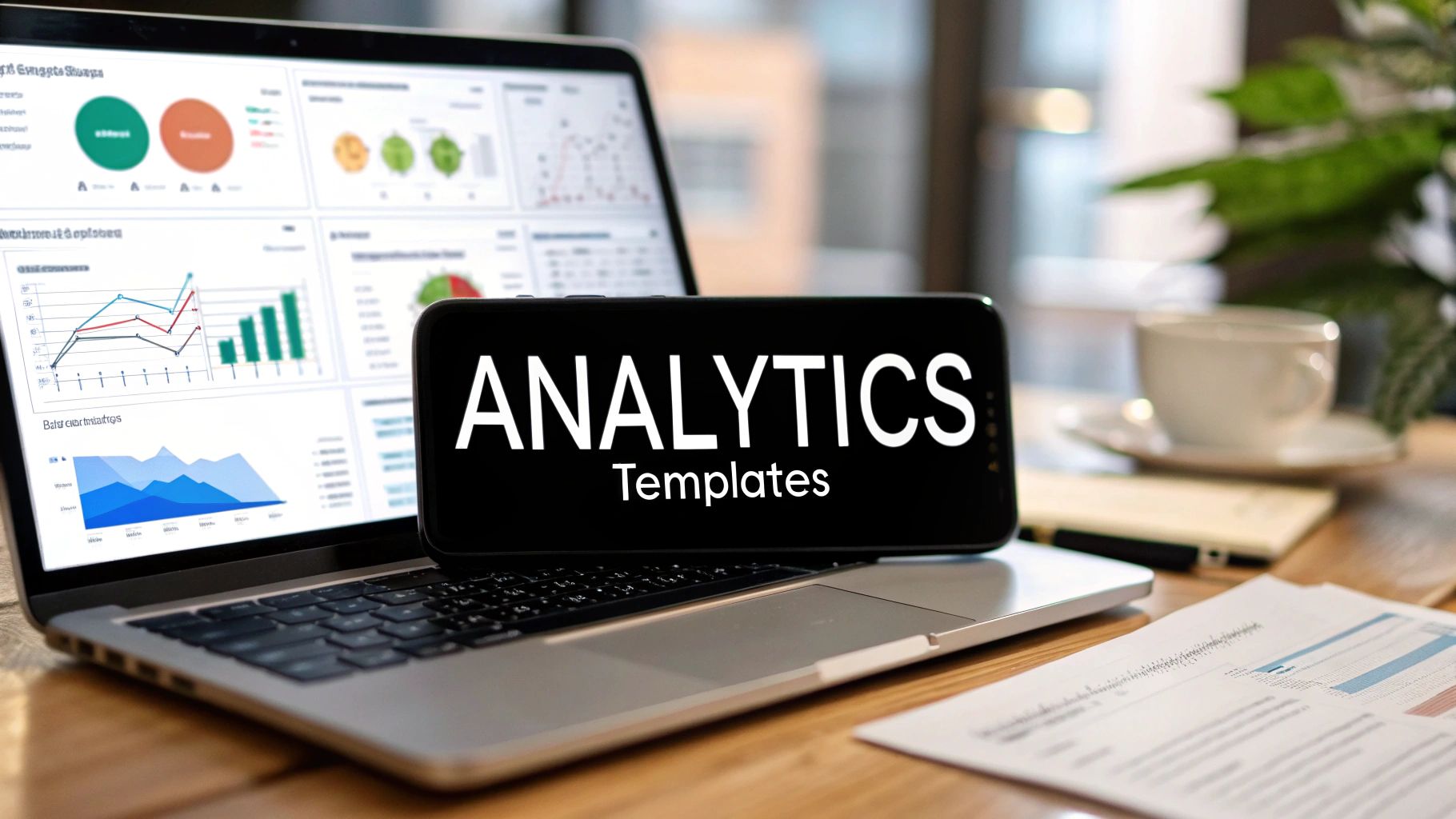
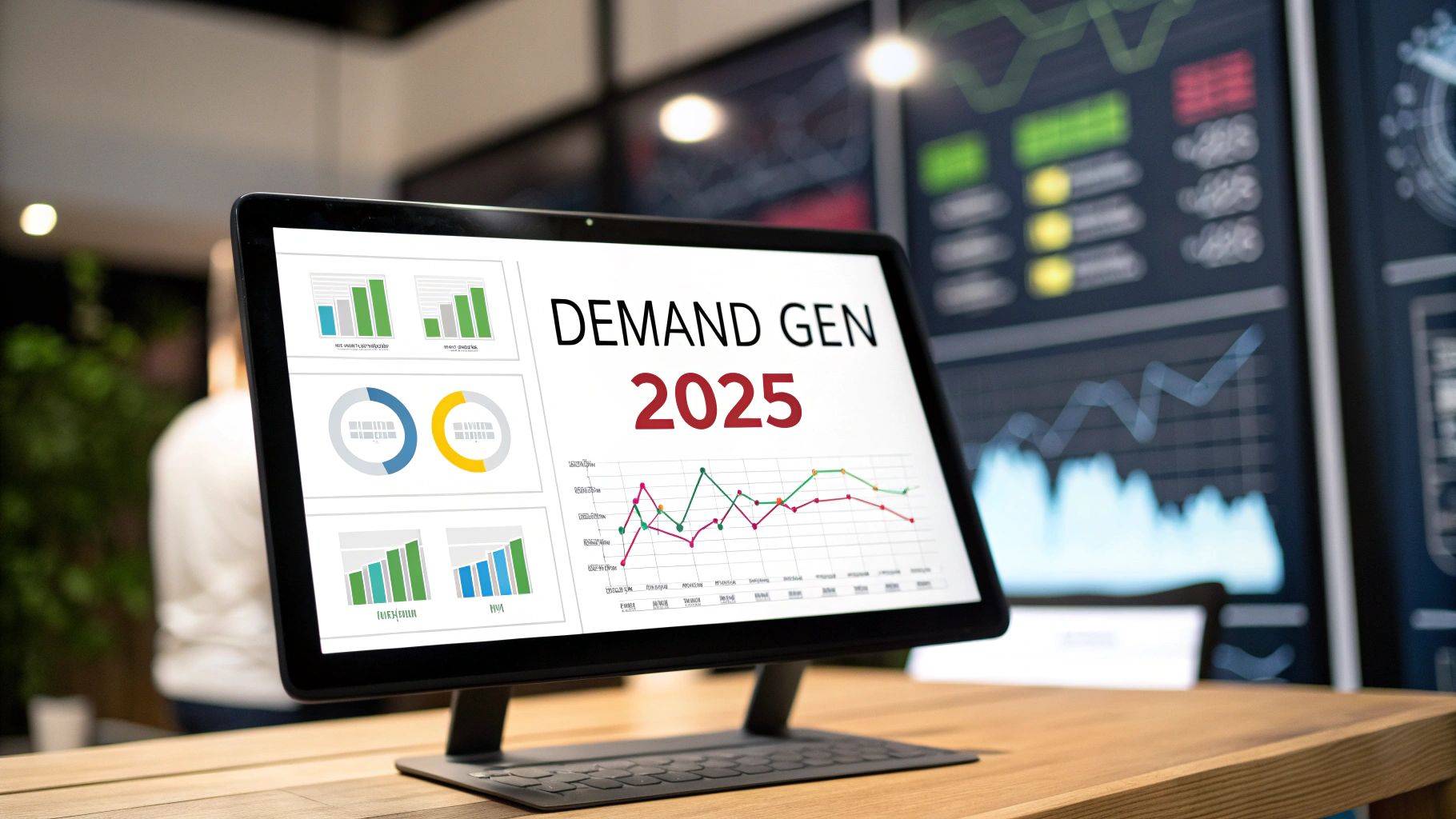
Comments